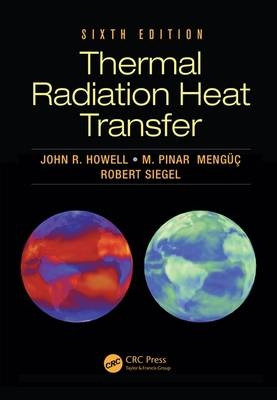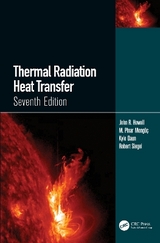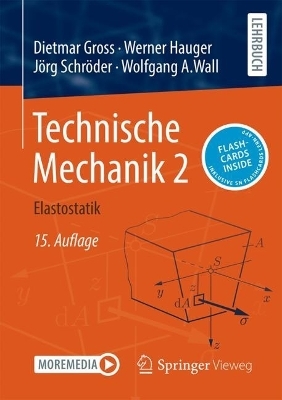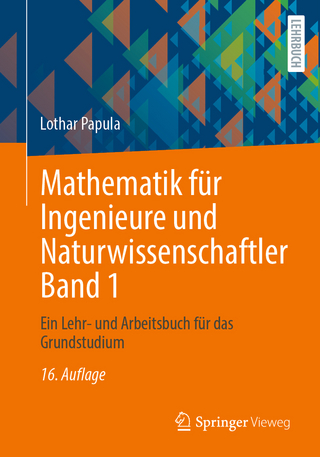
Thermal Radiation Heat Transfer
Crc Press Inc (Verlag)
978-1-4665-9326-8 (ISBN)
- Titel erscheint in neuer Auflage
- Artikel merken
Further expanding on the changes made to the fifth edition, Thermal Radiation Heat Transfer, 6th Edition continues to highlight the relevance of thermal radiative transfer and focus on concepts that develop the radiative transfer equation (RTE).
The book explains the fundamentals of radiative transfer, introduces the energy and radiative transfer equations, covers a variety of approaches used to gauge radiative heat exchange between different surfaces and structures, and provides solution techniques for solving the RTE.
What’s New in the Sixth Edition
This revised version updates information on properties of surfaces and of absorbing/emitting/scattering materials, radiative transfer among surfaces, and radiative transfer in participating media. It also enhances the chapter on near-field effects, addresses new applications that include enhanced solar cell performance and self-regulating surfaces for thermal control, and updates references.
Comprised of 17 chapters, this text:
Discusses the fundamental RTE and its simplified forms for different medium properties
Presents an intuitive relationship between the RTE formulations and the configuration factor analyses
Explores the historical development and the radiative behavior of a blackbody
Defines the radiative properties of solid opaque surfaces
Provides a detailed analysis and solution procedure for radiation exchange analysis
Contains methods for determining the radiative flux divergence (the radiative source term in the energy equation)
Thermal Radiation Heat Transfer, 6th Edition explores methods for solving the RTE to determine the local spectral intensity, radiative flux, and flux gradient. This book enables you to assess and calculate the exchange of energy between objects that determine radiative transfer at different energy levels.
John R. Howell received his academic degrees from Case Western Reserve University (Case Institute of Technology), Cleveland, Ohio. He began his engineering career as a researcher at NASA Lewis (Glenn) Research Center (1961–1968) and then took academic positions at the University of Houston (1978–1988) and the University of Texas at Austin, where he remained until retirement in 2012. He is presently Ernest Cockrell, Jr., Memorial Chair emeritus at The University of Texas. Howell pioneered the use of the Monte Carlo method for the analysis of radiative heat transfer in complex systems that contain absorbing, emitting, and scattering media. Robert Siegel received his ScD in mechanical engineering from Massachusetts Institute of Technology in 1953. For two years he worked at General Electric Company in the Heat Transfer Consulting Office and on analyzing the heat transfer characteristics of the Seawolf submarine nuclear reactor. He joined NASA in 1955 and was a senior research scientist at the Lewis/Glenn Research Center until he retired in 1999. He was an associate editor for the Journal of Heat Transfer and the Journal of Thermophysics and Heat Transfer. He has written numerous papers, and given graduate heat transfer courses as an adjunct professor at three universities. M. Pinar Mengüç completed his BSc and MS in mechanical engineering from the Middle East Technical University (METU) in Ankara, Turkey. He earned his PhD in mechanical engineering from Purdue University in 1985. He joined the University of Kentucky in 1985 and was promoted to associate and full professor in 1988 and 1993, respectively. In 2008, he became an Engineering Alumni Association professor .. In 2011 he joined Özyegin University in Istanbul as the founding head of the Mechanical Engineering Department and founding director of the Center for Energy, Environment, and Economy (CEEE).
Introduction to Radiative Transfer
Importance of Thermal Radiation in Engineering
Thermal Energy Transfer
Thermal Radiative Transfer
Radiative Energy Exchange and Radiative Intensity
Characteristics of Emission
Radiative Energy along a Line-of-Sight
Radiative Transfer Equation
Radiative Transfer in Enclosures with Nonparticipating Media
Concluding Remarks and Historical Notes
Homework
Radiative Properties at Interfaces
Introduction
Emissivity
Absorptivity
Reflectivity
Transmissivity at an Interface
Relations among Reflectivity, Absorptivity, Emissivity, and Transmissivity
Homework
Radiative Properties of Opaque Materials
Introduction
Electromagnetic Wave Theory Predictions
Extensions of the Theory for Radiative Properties
Measured Properties of Real Dielectric Materials
Measured Properties of Metals
Selective and Directional Opaque Surfaces
Concluding Remarks
Homework
Configuration Factors for Diffuse Surfaces with Uniform Radiosity
Radiative Transfer Equation for Surfaces Separated by a Transparent Medium
Geometric Configuration Factors between Two Surfaces
Methods for Determining Configuration Factors
Constraints on Configuration Factor Accuracy
Compilation of Known Configuration Factors and Their References: Appendix C and Web Catalog
Homework
Radiation Exchange in Enclosures Composed of Black and/or Diffuse-Gray Surfaces
Introduction
Radiative Transfer for Black Surfaces
Radiation between Finite Diffuse-Gray Areas
Radiation Analysis Using Infinitesimal Areas
Computer Programs for Enclosure Analysis
Homework
Exchange of Thermal Radiation among Nondiffuse Nongray Surfaces
Introduction
Enclosure Theory for Diffuse Nongray Surfaces
Directional-Gray Surfaces
Surfaces with Directionally and Spectrally Dependent Properties
Radiation Exchange in Enclosures with Specularly Reflecting Surfaces
Net-Radiation Method in Enclosures Having Both Specular and Diffuse Reflecting Surfaces
Multiple Radiation Shields
Concluding Remarks
Homework
Radiation Combined with Conduction and Convection at Boundaries
Introduction
Energy Relations and Boundary Conditions
Radiation Transfer with Conduction Boundary Conditions
Radiation with Convection and Conduction
Numerical Solution Methods
Numerical Integration Methods for Use with Enclosure Equations
Numerical Formulations for Combined-Mode Energy Transfer
Numerical Solution Techniques
Monte Carlo Method
Concluding Remarks
Homework
Inverse Problems in Radiative Heat Transfer
Introduction to Inverse Problems
General Inverse Solution Methods
Comparison of Methods for a Particular Problem
Application of Metaheuristic Methods
Unresolved Problems
Inverse Problems at the Nanoscale
Inverse Problems Involving Participating Media
Concluding Remarks
Homework
Properties of Absorbing and Emitting Media
Introduction
Spectral Lines and Bands for Gas Absorption and Emission
Band Models and Correlations for Gas Absorption and Emission
Gas Total Emittance Correlations
True Absorption Coefficient
Radiative Properties of Translucent Liquids and Solids
Homework
Fundamental Radiative Transfer Relations
Introduction
Energy Equation and Boundary Conditions for a Participating Medium
Radiative Transfer and Source-Function Equations
Radiative Flux and Its Divergence within a Medium
Summary of Relations for Radiative Transfer in Absorbing, Emitting, and Scattering Media
Treatment of Radiation Transfer in Non-LTE Media
Net Radiation Method for Enclosures Filled with an Isothermal Medium of Uniform Composition
Evaluation of Spectral Geometric-Mean Transmittance and Absorptance Factors
Mean Beam Length Approximation for Spectral Radiation from an Entire Volume of a Medium to All or Part of Its Boundary
Exchange of Total Radiation in an Enclosure by Use of Mean Beam Length
Optically Thin and Cold Media
Homework
Radiative Transfer in Plane Layers and Multidimensional Geometries
Introduction
Radiative Intensity, Flux, Flux Divergence, and Source Function in a Plane Layer
Gray Plane Layer of Absorbing and Emitting Medium with Isotropic Scattering
Gray Plane Layer in Radiative Equilibrium
Multidimensional Radiation in a Participating Gray Medium with Isotropic Scattering
Homework
Solution Methods for Radiative Transfer in Participating Media
Introduction
Series Expansion and Moment Methods
Discrete Ordinates (SN) Method
Other Methods That Depend on Angular Discretization
Zonal Method
Monte Carlo Technique for Radiatively Participating Media
Additional Solution Methods
Comparison of Results for the Methods
Benchmark Solutions for Computational Verification
Inverse Problems Involving Participating Media
Use of Mean Absorption Coefficients
Solution Using Commercial Codes
Homework
Conjugate Heat Transfer in Participating Media
Introduction
Radiation Combined with Conduction
Transient Solutions Including Conduction
Combined Radiation, Conduction, and Convection in a Boundary Layer
Numerical Solution Methods for Combined Radiation, Conduction, and Convection in Participating Media
Combined Radiation, Convection, and Conduction Heat Transfer
Inverse Multimode Problems
Verification, Validation, and Uncertainty Quantification
Homework
Electromagnetic Wave Theory
Introduction
EM Wave Equations
Wave Propagation in a Medium
Laws of Reflection and Refraction
Amplitude and Scattering Matrices
EM Wave Theory and the Radiative Transfer Equation
Homework
Absorption and Scattering by Particles and Agglomerates
Overview
Absorption and Scattering: Definitions
Scattering by Spherical Particles
Scattering by Small Particles
Lorenz-Mie Theory for Spherical Particles
Prediction of Properties for Irregularly Shaped Particles
Approximate Anisotropic Scattering Phase Functions
Dependent Absorption and Scattering
Homework
Near-Field Thermal Radiation
Introduction
Electromagnetic Treatment of Thermal Radiation and Basic Concepts
Evanescent and Surface Waves
Near-Field Radiative Heat Flux Calculations
Computational Studies of Near-Field Thermal Radiation
Experimental Studies of Near-Field Thermal Radiation
Concluding Remarks
Homework
Acknowledgment
Radiative Effects in Translucent Solids, Windows, and Coatings
Introduction
Transmission, Absorption, and Reflection of Windows
Enclosure Analysis with Partially Transparent Windows
Effects of Coatings or Thin Films on Surfaces
Refractive Index Effects on Radiation in a Participating Medium
Multiple Participating Layers with Heat Conduction
Light Pipes and Fiber Optics
Final Remarks
Homework
A: Conversion Factors, Radiation Constants, and Blackbody Functions
B: Radiative Properties
Catalog of Selected Configuration Factors
Exponential Integral Relations and Two-Dimensional Radiation Functions
E: References
| Erscheint lt. Verlag | 5.10.2015 |
|---|---|
| Zusatzinfo | 4921 Equations; 54 Tables, black and white; 646 Illustrations, black and white |
| Verlagsort | Bosa Roca |
| Sprache | englisch |
| Maße | 178 x 254 mm |
| Gewicht | 1950 g |
| Themenwelt | Mathematik / Informatik ► Mathematik ► Angewandte Mathematik |
| Naturwissenschaften ► Physik / Astronomie ► Thermodynamik | |
| Technik ► Elektrotechnik / Energietechnik | |
| Technik ► Umwelttechnik / Biotechnologie | |
| ISBN-10 | 1-4665-9326-1 / 1466593261 |
| ISBN-13 | 978-1-4665-9326-8 / 9781466593268 |
| Zustand | Neuware |
| Informationen gemäß Produktsicherheitsverordnung (GPSR) | |
| Haben Sie eine Frage zum Produkt? |
aus dem Bereich



